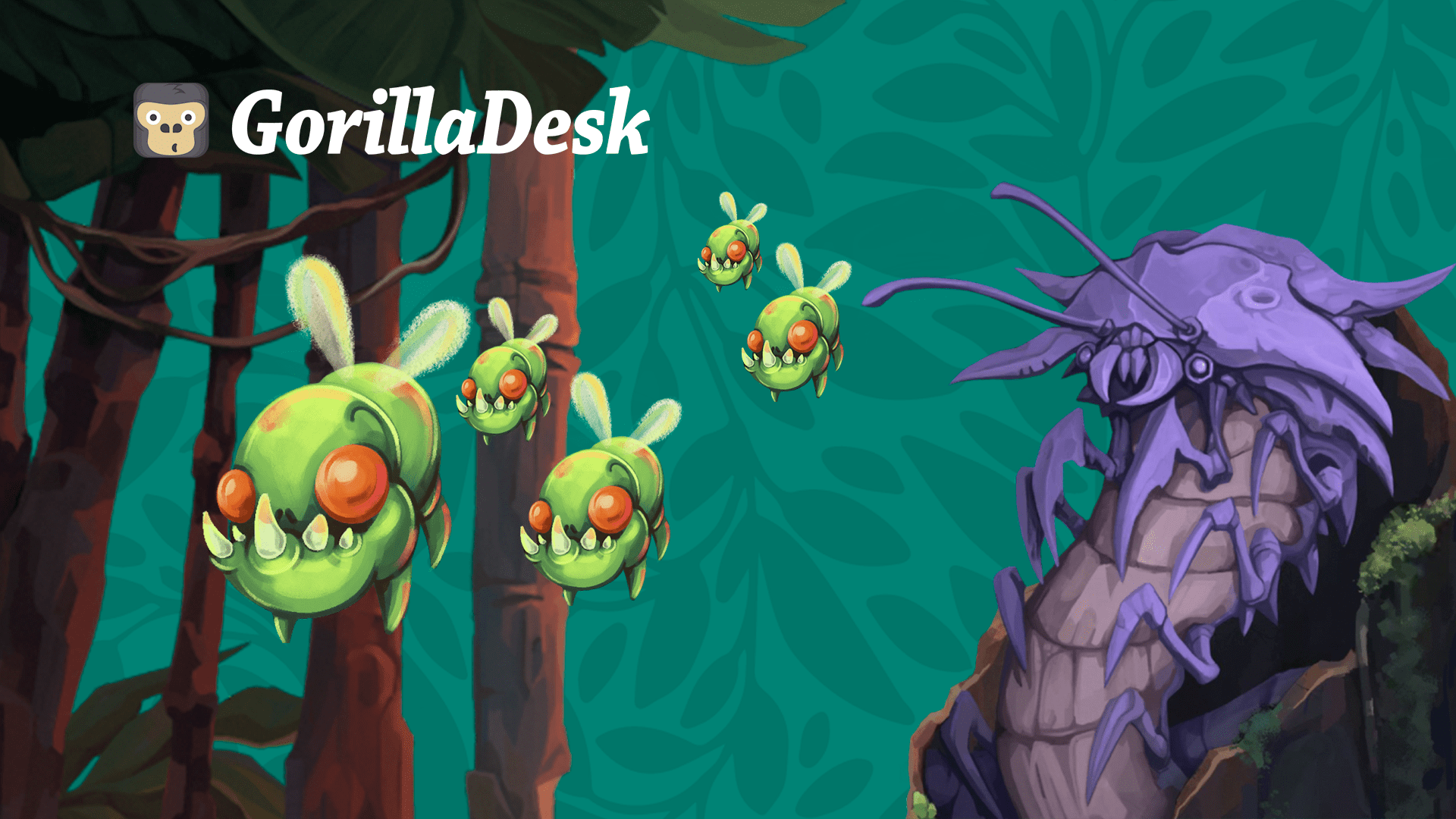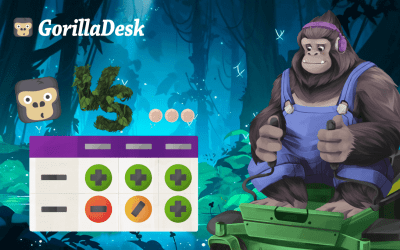How to set competitive pest control prices (+ average costs in 2024)
GorillaDesk Staff

Understanding current pest control prices is essential for staying competitive. Not to mention, regularly checking your competitors’ prices helps you nail down your own pricing strategy. In turn, you’ll gain the insights to reinvest in your business without losing customers to a lower-priced company down the road.
We’ll walk you through the latest average cost of pest control services and break down which factors can influence costs. Keep reading to learn all you need to know about average pest control prices to maximize your pest control company profit margin.
How much does pest control cost in 2024?
Assessing the average nationwide cost is a great place to start understanding current prices. In the US, pest control services range from $108 to $261. The price depends on several factors, including location and methods of treatment.
Average pest control costs by metro area
Location is another huge factor that influences pricing. Here’s the average pest control cost for various metro areas in the US:
- Atlanta, GA: $55–$225
- Boston, MA: $70–$275
- Chicago, IL: $60–$230
- Dallas, TX: $55–$210
- Denver, CO: $55–$215
- Honolulu, HI: $60–$245
- Los Angeles, CA: $44–$215
- New York City, NY: $65–$260
- Phoenix, AZ: $50–$205
- Seattle, WA: $55–$220
Pest control in large metro areas like New York City often costs more due to higher labor costs and demand. Additionally, the cost of fuel and taxes influence regional price differences.
Average cost by pest control treatment type
Pest control service costs vary depending on whether chemicals, fumigation, or physical removal are used. According to Home Advisor, here are the average costs of different pest control treatment methods:
- Chemical treatments: $200–$1,000 per room
- Fumigation: $1–$4 per square foot; $2,000–$8,000 for a 2,000-square-foot home
- Physical removal: $300–$700
If fumigation is necessary, prices depend on the size of the home. If tenting isn’t required, the cost may be quite a bit less.
Average price range by pest type
Different pest infestations incur different costs, and common household pests typically cost less. Home Advisor found that mosquitoes and fleas are often the lowest cost, with a low-end price of $70 and $75, respectively. However, a large mosquito infestation could cost $1,900 at the high end—surpassed only by bedbugs at a $5,000 high-end cost.
Here are the average prices of treatments for common types of pests as reported by Home Advisor:
- Ants: $100–$500
- Bats: $240–$670
- Bedbugs: $300–$5,000
- Cockroaches: $100–$400
- Fleas: $75–$400
- Mosquitoes: $70–$1,900
- Rodents: $180–$540
- Spiders: $150–$500
- Termites: $230–$940
- Wasps: $100–$1,300
The differences in price by pest type are largely due to the labor and materials required. For example, a single wasp nest requires less labor and materials to remove than a major termite infestation.
Cost of one-time vs. recurring pest control services
Pest control pricing also depends on whether a homeowner requires a one-time visit or recurring treatments. According to Angi, here‘s the average cost for one-time versus recurring pest control services:
- One-time treatment: $300–$550
- Recurring service initial visit cost: $150–$300
- Monthly treatments: $40–$70
- Quarterly treatments: $100–$300
- Annual pest control treatments: $300–$550
One-time pest control services cost more upfront due to the labor and supplies needed for an initial inspection and targeted treatment. Recurring services, on the other hand, cost less upfront and less per visit, often thanks to discounted rates offered by pest control businesses.
What costs less in the long run?
While one-time services require a one-time payment, recurring services may cost less in the long run thanks to ongoing prevention and treatment of pest infestations. You can remind customers that ongoing treatment is more cost-effective over time than paying for repeat one-time treatments.
Let’s say your customer has an ant infestation. If they choose a one-time treatment, that costs $300 on the low end. But if your pest control company needs to revisit the same home three times over the year to apply new treatments, that quickly adds up to $1,200 for four visits.
On the other hand, let’s say your customer chooses a quarterly pest control plan that costs $150 for an initial assessment plus $100 each quarter. This totals up to $550, which is less than half of the $1,200 they’d spend on four single visits.
What factors influence pest control company prices?
These seven factors can affect how you price your professional pest control services. Be sure to consider how each one may impact the way your customers perceive the value and affordability of your services.
1. Location
Pest control prices are often higher in areas with a high cost of living, like New York City or San Francisco. This is often related to higher labor and supply costs.
Additionally, warmer climates can drive demand and competition, resulting in lower, more competitive prices. IBISWorld found pest control companies are more numerous in the Southeastern U.S. thanks to its warm climate, which allows pests to live longer.
Travel can also influence the cost of pest prevention and extermination. Jobs in more remote areas or locations that are harder to reach often cost more due to increased fuel consumption.
2. Type of pest
Different pest infestations require different treatment methods, equipment, and amounts of labor. For example, seasonal pests like mosquitoes may only require a one-time treatment each year, while rodents, termites, or carpenter ants require recurring treatments.
Additionally, certain types of pests are more invasive and may require more costly treatments. Termites, for example, may require fumigation of a whole house, driving up the cost of treating the pest infestation.
3. Size and severity of pest infestation
The size of your treatment area also influences price. More supplies and labor are needed to thoroughly inspect, treat, and monitor larger areas. Treating one room of a house costs less than treating a whole-home infestation of bedbugs, for example.
4. Accessibility of the treatment area
Pest control pricing also changes depending on how accessible the treatment area is. A technician can easily inspect and treat an infestation of ants in a kitchen. But removing critters from a chimney or attic requires a more hands-on approach to accessing the area.
5. Frequency of treatment
If an infestation requires recurring treatments, it typically incurs a lower per-visit cost than a one-time pest control service. For example, termite extermination likely requires multiple visits and monitoring to fully eradicate the infestation and ensure it doesn’t reoccur.
6. Population changes
If your pest control business is located in an area where population density and urbanization increase, you may see a jump in demand. The presence of higher-income areas may increase customers’ willingness to pay higher prices for premium pest control services.
7. Housing markets and economic conditions
A growing housing market leads to more new homeowners who may need inspections or treatment from your pest control business. On the other hand, stagnant or shrinking housing markets reduce the number of new homeowners.
Economic recessions can also reduce demand for pest control services as customers cut back on costs. This means you may need to adjust your pricing to remain profitable.
How to set your pest control prices
Setting pest control prices can feel daunting. You don’t want to set prices so low that you go out of business—or set them so high that you drive customers away. Here’s what you need to know to set competitive yet profitable prices:
1. Understand your costs and profit margins
It’s essential to pinpoint your break-even point, or how much revenue you need to cover all your costs. This lets you set pest control prices that keep your profit margins healthy. To do this, you need to list all your business costs.
Common pest control service costs include the following:
- Business license and certifications
- Business and vehicle insurance
- Pest treatment supplies and equipment
- Office supplies and equipment
- Pest control software
- Employee wages and benefits
- Advertising and marketing costs like Yelp and direct mail
Tracking individual types of pest control costs highlights areas where you can improve efficiency and, therefore, your profit margin.
A profit margin of 15–20% is considered great—the three largest pest control companies in the U.S. had margins of 15.7–19.5% in 2023, according to IBISWorld. However, larger companies can scale and grow their profit margins faster than smaller companies.
2. Analyze your competition
If you operate in a competitive market, your profit margin may not be as high. Even if you only compete with a few other local pest control services, it’s a good idea to regularly assess your competition and their prices. This provides insights into the pest control service offerings, pricing strategies, and marketing efforts that make competing businesses successful. And you can use these insights to craft your own successful strategies.
Additionally, it’s a good idea to identify your competitors’ strengths and weaknesses. This helps you spot any unmet needs in your local market or areas where you can easily outperform other pest control businesses. Customer reviews also tell you whether other pest control companies aren’t meeting current needs.
3. Use pricing strategies
There are several different pricing strategies commonly used in the pest control industry. The best strategy for your business depends on your local market and competition, your ideal customers, and your financial goals. You may even find a combination of the following pricing strategies provides the best outcomes.
Competitive pricing
This pricing strategy uses local market data to ensure your prices stay competitive. If your target market includes price-sensitive customers, then competitive pricing may help you maintain a target profit margin.
Pros:
- Prices match market fluctuations
- Price-sensitive customers may find it more appealing
Cons:
- Profit margins may be lower to stay competitive
- It may be difficult to differentiate your services based on value
Cost-plus pricing
When using cost-plus pricing, you price your services based on the cost associated with that service plus a markup. This strategy ensures your business maintains a minimum profit margin.
Pros:
- Simple to calculate pest control prices
- A minimum profit margin is guaranteed
Cons:
- It doesn’t always reflect the value of your services
- It doesn’t account for your local market or competition
Seasonal pricing
You can adjust your pest control prices to account for peak and off-peak pest seasons. This helps you maintain your profit margins even when demand wanes, as well as stay competitive when demand grows.
Pros:
- You can adjust prices to match demand levels
- It’s easier to maintain profitability during off-peak seasons
Cons:
- Price changes may turn customers away
- You need to continuously monitor your local market
Tiered pricing
Many pest control businesses use tiered pricing, which offers different service tiers and price points. These service tiers provide customers with options that match their budgets and preferences. Typically, the middle tier package offers the best value for customers and the most profit for businesses.
Pros:
- Customers get more service options
- Businesses maximize profits and appeal to more customers
Cons:
- A balanced approach is necessary to avoid deterring customers from higher- and lower-priced packages
Value-based pricing
This strategy involves setting your pest control cost based on the value your customers associate with it. This can maximize your profit margins, but you’ll need to extensively research your customers and competition.
Pros:
- Prices are based on customers’ perceived value
- Maximum profit margins are achievable
Cons:
- In-depth market and customer research is required
- Competitors may offer lower-priced services
Other pricing strategies used by professional pest control companies include offering bundled services, discounted pest control plans, and referral incentives.
4. Test and adjust pest control prices regularly
Tracking certain metrics helps you understand the effectiveness of your prices. Important metrics to regularly analyze include the following:
- Profit margin
- Revenue per service
- Cost per service
- Customer acquisition cost
- Customer retention rate
You should also seek to understand your customers’ pest control needs as best you can—and what they’re willing to pay. Dig into reviews and feedback for valuable insights.
Increase your pest control business efficiency with GorillaDesk
Streamlining your processes, like scheduling and routing, can reduce business costs. More efficiency also lets you highlight speed and reliability as value propositions, which can draw more customers to your business.
Investing in pest control software like GorillaDesk helps you do more pest wrangling, more efficiently. And GorillaDesk helps you find the most optimal technician routes to lower fuel costs and travel time.
Find out how GorillaDesk keeps your pest control business running smoothly and start your free 14-day trial today.
Other posts to check out
Make the move from paper to digital: A step-by-step guide for field service pros
If your field service business is still doing business on paper, it’s time to make a change. Here’s how to find success with a move to digital.
Pest control marketing: Let’s make that phone ring
With so many other local pest control companies making competition tight, keeping that phone ringing with new customers may not feel as easy as you thought. To keep your pest control business growing takes marketing know-how. Here are our best tips.
How to get more positive customer feedback
Customers trust online reviews just as much as word of mouth from friends and family. The truth is: Online reviews can make or break your local services business. Here’s how to build that glowing reputation your service deserves.
Tree service marketing: 11+ ideas to drive more customers in 2025
Drive more leads with our ultimate tree service marketing guide! Discover 11+ proven strategies to grow your business and attract the right customers.
How to start a tree service business in 2025
Learn how to start a tree service business with step-by-step guidance on planning, licensing, equipment, marketing, safety, and scaling your company.
Landscaping services list: What to offer your customers
Discover the top landscaping services to offer for maximum profit. From design to maintenance, expand your business with our comprehensive landscaping services list.
Transform your business
Try it free for 14 days. No credit card required. Instant setup.
★★★★★
We will be customers for life
“I can not say enough good things about GorillaDesk it saves us so much time and money. The customer service is the best. I would recommend GorillaDesk to anyone no matter what industry. I trained my employee in 5 minutes on how to use it. We will be customers for life.”

Ryan Sullivan
Business Owner
Ready to Get Started?
Get all our amazing features and top-rated support, with no credit card required.






